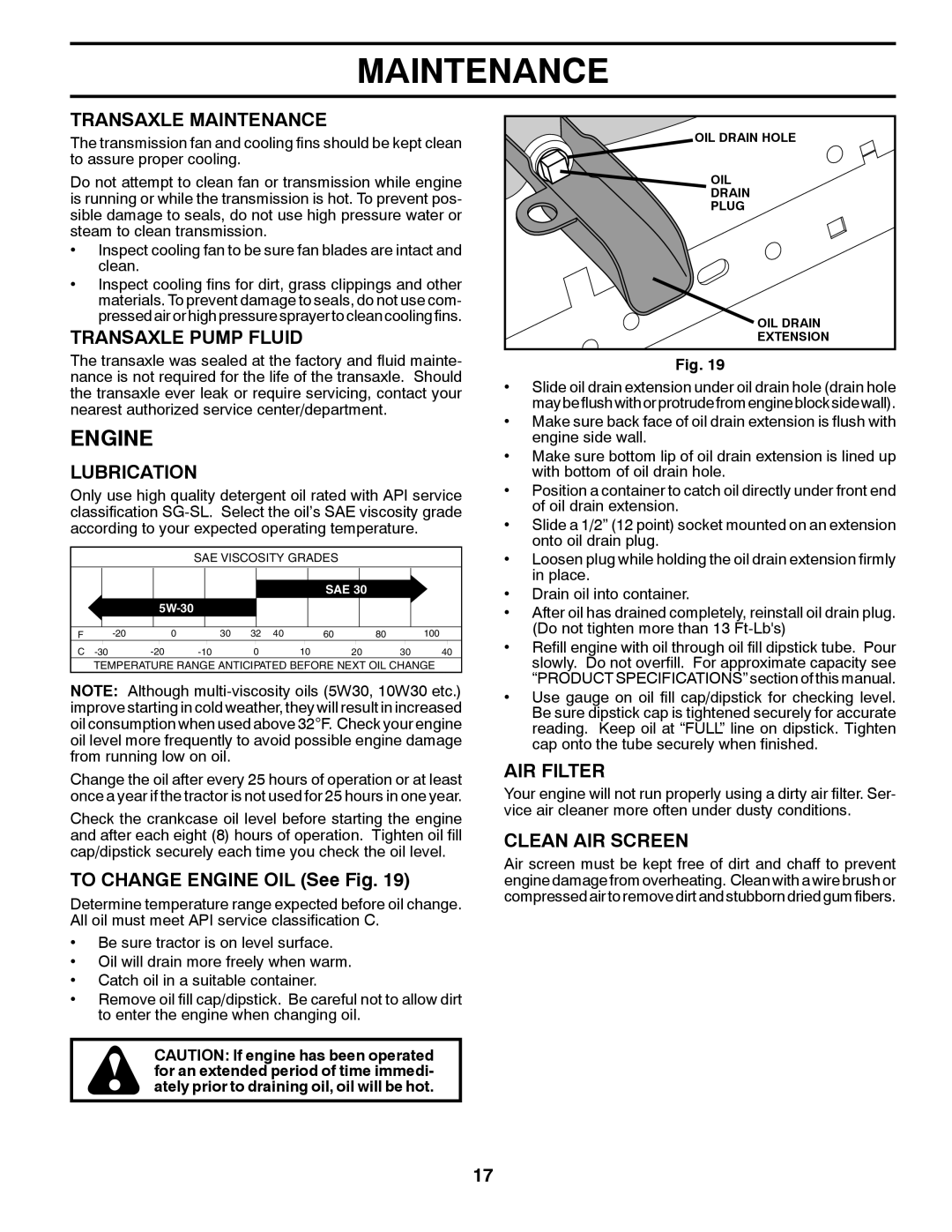
MAINTENANCE
TRANSAXLE MAINTENANCE
The transmission fan and cooling fins should be kept clean to assure proper cooling.
Do not attempt to clean fan or transmission while engine is running or while the transmission is hot. To prevent pos- sible damage to seals, do not use high pressure water or steam to clean transmission.
•Inspect cooling fan to be sure fan blades are intact and clean.
•Inspect cooling fins for dirt, grass clippings and other materials. To prevent damage to seals, do not use com- pressed air or high pressure sprayer to clean cooling fins.
TRANSAXLE PUMP FLUID
The transaxle was sealed at the factory and fluid mainte- nance is not required for the life of the transaxle. Should the transaxle ever leak or require servicing, contact your nearest authorized service center/department.
ENGINE
LUBRICATION
Only use high quality detergent oil rated with API service classification
SAE VISCOSITY GRADES
|
|
|
|
|
|
|
|
|
| SAE 30 |
|
|
|
|
|
|
|
|
|
|
|
|
|
| |
|
|
|
|
|
|
|
|
|
|
|
|
|
F | 0 |
|
| 30 32 40 |
| 60 | 80 | 100 | ||||
C | 0 | 10 | 20 | 30 | 40 | |||||||
TEMPERATURE RANGE ANTICIPATED BEFORE NEXT OIL CHANGE
NOTE: Although
Change the oil after every 25 hours of operation or at least once a year if the tractor is not used for 25 hours in one year.
Check the crankcase oil level before starting the engine and after each eight (8) hours of operation. Tighten oil fill cap/dipstick securely each time you check the oil level.
TO CHANGE ENGINE OIL (See Fig. 19)
Determine temperature range expected before oil change. All oil must meet API service classification C.
•Be sure tractor is on level surface.
•Oil will drain more freely when warm.
•Catch oil in a suitable container.
•Remove oil fill cap/dipstick. Be careful not to allow dirt to enter the engine when changing oil.
CAUTION: If engine has been operated for an extended period of time immedi- ately prior to draining oil, oil will be hot.
OIL DRAIN HOLE |
OIL |
DRAIN |
PLUG |
OIL DRAIN |
EXTENSION |
Fig. 19
•Slide oil drain extension under oil drain hole (drain hole maybeflushwithorprotrudefromengineblocksidewall).
•Make sure back face of oil drain extension is flush with engine side wall.
•Make sure bottom lip of oil drain extension is lined up with bottom of oil drain hole.
•Position a container to catch oil directly under front end of oil drain extension.
•Slide a 1/2” (12 point) socket mounted on an extension onto oil drain plug.
•Loosen plug while holding the oil drain extension firmly in place.
•Drain oil into container.
•After oil has drained completely, reinstall oil drain plug. (Do not tighten more than 13
•Refill engine with oil through oil fill dipstick tube. Pour slowly. Do not overfill. For approximate capacity see “PRODUCT SPECIFICATIONS” section of this manual.
•Use gauge on oil fill cap/dipstick for checking level. Be sure dipstick cap is tightened securely for accurate reading. Keep oil at “FULL” line on dipstick. Tighten cap onto the tube securely when finished.
AIR FILTER
Your engine will not run properly using a dirty air filter. Ser- vice air cleaner more often under dusty conditions.
CLEAN AIR SCREEN
Air screen must be kept free of dirt and chaff to prevent engine damage from overheating. Clean with a wire brush or compressed air to remove dirt and stubborn dried gum fibers.
17
